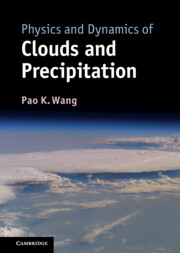Book contents
- Frontmatter
- Contents
- Preface
- 1 Observation of clouds
- 2 The shape and size of cloud and precipitation particles
- 3 Molecular structures of water substance
- 4 Bulk thermodynamic equilibrium among water vapor, liquid water, and ice
- 5 Surface thermodynamics of water substance
- 6 Aerosol in the atmosphere
- 7 Nucleation
- 8 Hydrodynamics of cloud and precipitation particles
- 9 Diffusion growth and evaporation of cloud and precipitation particles
- 10 Collision, coalescence, breakup, and melting
- 11 Cloud drop population dynamics in the warm rain process
- 12 Fundamental cloud dynamics
- 13 Numerical cloud models
- 14 Cloud electricity
- 15 Clouds–environment interaction
- References
- Index
- Plate section
9 - Diffusion growth and evaporation of cloud and precipitation particles
Published online by Cambridge University Press: 05 March 2013
- Frontmatter
- Contents
- Preface
- 1 Observation of clouds
- 2 The shape and size of cloud and precipitation particles
- 3 Molecular structures of water substance
- 4 Bulk thermodynamic equilibrium among water vapor, liquid water, and ice
- 5 Surface thermodynamics of water substance
- 6 Aerosol in the atmosphere
- 7 Nucleation
- 8 Hydrodynamics of cloud and precipitation particles
- 9 Diffusion growth and evaporation of cloud and precipitation particles
- 10 Collision, coalescence, breakup, and melting
- 11 Cloud drop population dynamics in the warm rain process
- 12 Fundamental cloud dynamics
- 13 Numerical cloud models
- 14 Cloud electricity
- 15 Clouds–environment interaction
- References
- Index
- Plate section
Summary
The nucleation we discussed in Chapter 7 is about the initiation of condensed phases of cloud and precipitation particles. Our next question is this: Once these particles are initiated, how do they grow and how fast? This is what we will address in the next two chapters.
There are two broad categories of particle growth modes: (1) diffusion growth and (2) collision growth. The former refers to the mechanism in which water vapor diffuses toward the surface of a particle, resulting in the increase of the particle’s mass. The latter refers to the collision between two or more particles, which subsequently coalesce together and hence become a larger particle. The latter can mean collisions among water drops, among water drops and ice particles, or among ice particles.
The reverse of growth is reduction. Both water drops and ice particles can decrease their size by evaporation and fragmentation. Ice particles can also melt to become liquid and thus reduce their size.
Diffusion of water vapor around a spherical water drop
When a water drop is suspended in supersaturated air (with respect to the drop), then there will be net deposition of water molecules on the drop surface and the drop grows in size. This is the diffusion growth of water drops. Note that the saturation humidity here should take into account both the curvature and solute effects as discussed in Chapter 5.
- Type
- Chapter
- Information
- Physics and Dynamics of Clouds and Precipitation , pp. 228 - 251Publisher: Cambridge University PressPrint publication year: 2013
- 2
- Cited by



